The Metamaterial Market is estimated to be valued at USD 1.1 billion in 2025 and is projected to reach USD 6.2 billion by 2035, registering a compound annual growth rate (CAGR) of 18.8% over the forecast period.
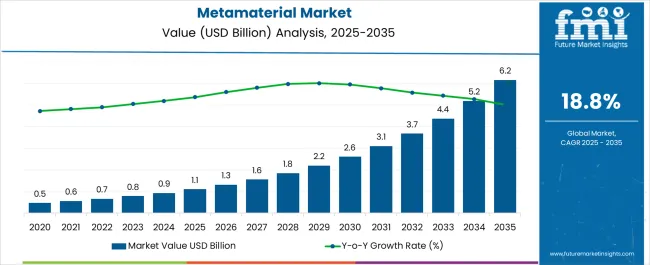
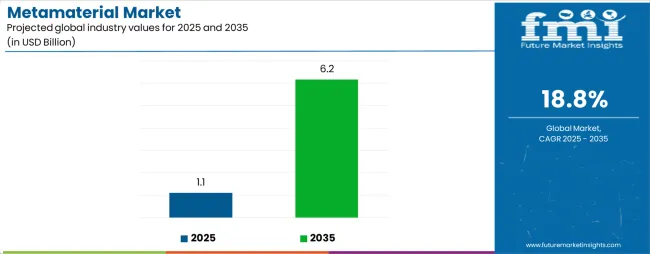
| Metric | Value |
|---|---|
| Metamaterial Market Estimated Value in (2025 E) | USD 1.1 billion |
| Metamaterial Market Forecast Value in (2035 F) | USD 6.2 billion |
| Forecast CAGR (2025 to 2035) | 18.8% |
The Metamaterial market is experiencing significant growth, driven by the increasing demand for advanced materials with unique electromagnetic, acoustic, and optical properties across aerospace, defense, telecommunications, and industrial applications. Adoption is being fueled by the ability of metamaterials to manipulate electromagnetic waves, improve antenna performance, and enable miniaturization of devices while reducing weight and energy consumption.
Advancements in fabrication techniques, such as 3D printing and nanostructuring, have enhanced precision and performance, facilitating broader application in next-generation communication systems and defense technologies. Government and private sector investments in research and development for high-performance materials are accelerating innovation and commercialization.
The growing focus on lightweight, high-strength, and multifunctional materials is further driving market expansion As industries seek efficient, high-performance solutions for complex engineering challenges, the metamaterial market is positioned for sustained growth, supported by continuous technological innovation, increasing integration into advanced systems, and heightened global demand for intelligent, adaptable materials across critical sectors.
The metamaterial market is segmented by material type, application, end-use industry, and geographic regions. By material type, metamaterial market is divided into Electromagnetic Metamaterial, Frequency Band Metamaterial, Terahertz Metamaterial, Photonic Metamaterial, Tunable Metamaterial, Plasmonic Met Material, and Other Types (Elastic, Acoustic, Structural, Etc.). In terms of application, metamaterial market is classified into Antenna, Solar Panel, Sensors, Absorber, Medical Imaging, Superlens, Seismic Protection, Sound Filtering, and Other. Based on end-use industry, metamaterial market is segmented into Aerospace & Defense, Electronics & Telecommunication, Automotive, Power Plants, and Medical. Regionally, the metamaterial industry is classified into North America, Latin America, Western Europe, Eastern Europe, Balkan & Baltic Countries, Russia & Belarus, Central Asia, East Asia, South Asia & Pacific, and the Middle East & Africa.
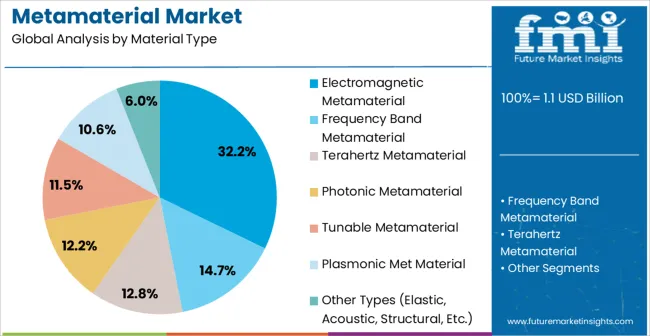
The electromagnetic metamaterial segment is projected to hold 32.2% of the market revenue in 2025, establishing it as the leading material type. Its growth is being driven by the ability to control and manipulate electromagnetic waves, which is critical for enhancing antenna performance, wireless communication, and radar applications.
The unique properties of electromagnetic metamaterials, including negative refractive index and high-frequency tunability, enable miniaturization of devices and reduction of energy losses. Continuous advancements in material design, computational modeling, and fabrication processes have strengthened reliability, scalability, and integration capabilities, supporting adoption across aerospace, defense, and telecommunication sectors.
Increasing demand for efficient communication systems, improved signal processing, and high-precision sensor applications has further reinforced its market position As industries continue to prioritize lightweight, high-performance, and multifunctional materials, the electromagnetic metamaterial segment is expected to maintain its leading share, supported by ongoing innovation and broader application deployment in next-generation technologies.
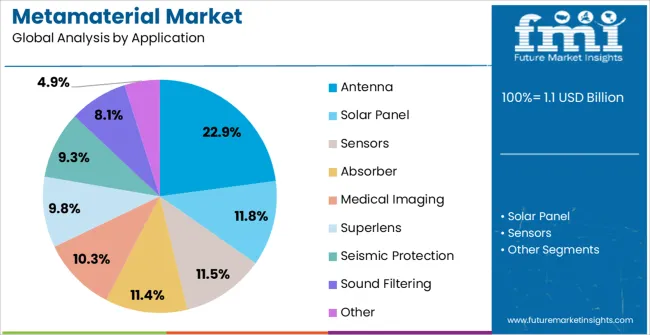
The antenna application segment is anticipated to account for 22.9% of the market revenue in 2025, making it the leading application area. Growth in this segment is being driven by the rising need for compact, high-performance antennas in wireless communication, satellite systems, and defense technologies. Metamaterial-enabled antennas provide enhanced signal strength, bandwidth, and directional control while reducing device size and weight.
The ability to integrate these antennas into complex systems without compromising efficiency has accelerated adoption. Advancements in electromagnetic design and simulation tools allow manufacturers to optimize antenna performance for various operational environments.
Increased demand for high-speed data transmission, 5G networks, and advanced radar and sensing systems further supports segment growth As communication and defense systems continue to require efficient, reliable, and miniaturized antenna solutions, the antenna application segment is expected to remain the primary driver of market expansion, reinforced by continuous research, development, and deployment of metamaterial-based technologies.
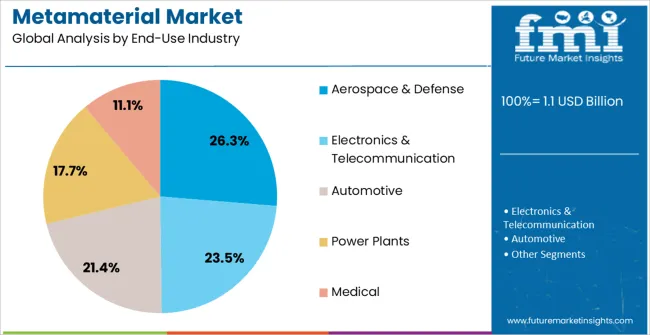
The aerospace and defense segment is projected to hold 26.3% of the market revenue in 2025, establishing it as the leading end-use industry. Growth is being driven by the demand for lightweight, high-strength, and multifunctional materials that enhance system performance and efficiency in aircraft, satellites, and defense platforms.
Metamaterials provide unique properties, such as electromagnetic wave manipulation, radar cross-section reduction, and improved structural integrity, which are critical for advanced aerospace and defense applications. Continuous advancements in material engineering, fabrication processes, and computational modeling have enabled more precise and reliable integration of metamaterials into critical systems.
Increased investment in defense modernization programs, space exploration initiatives, and next-generation military technologies is further supporting adoption As aerospace and defense organizations prioritize efficiency, performance, and multifunctionality, the sector is expected to remain the largest revenue contributor, with metamaterials playing a central role in driving innovation, system optimization, and operational capabilities across advanced applications.
Metamaterial is an engineered material designed to attain properties that are not found in nature. Metamaterials are made of multiple composite materials such as metals, plastics, etc. fashioned in repeating patterns. These artificially structured composite exhibits exotic and unique properties such as electromagnetic properties, compared with traditional composites found in nature.
Superior electromechanical properties makes it idle material for various applications in telecommunication industry. Metamaterial also find a significant application in several end-use verticals such as, medical, automotive, consumer electronics, optics, aerospace and energy & power. Different types of materials are used for different applications depending upon the properties required by the end use verticals.
Metamaterial show exceptional physical properties such as, negative permittivity & permeability and negative index of refraction have attracted significant research and development activities. The significance of metamaterial is that it can affect waves of electromagnetic radiation or sound and allowing engineers to manipulate wave propagation by modifying unit cells in different ways.
With the advancement of technologies and increasing application of consumable electronics and growth of telecommunication industry the metamaterial market is expected to be a lucrative market having a significant growth over the forecast period.
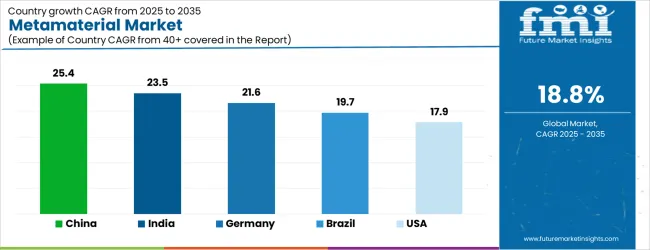
| Country | CAGR |
|---|---|
| China | 25.4% |
| India | 23.5% |
| Germany | 21.6% |
| Brazil | 19.7% |
| USA | 17.9% |
| UK | 16.0% |
| Japan | 14.1% |
The Metamaterial Market is expected to register a CAGR of 18.8% during the forecast period, exhibiting varied country level momentum. China leads with the highest CAGR of 25.4%, followed by India at 23.5%. Developed markets such as Germany, France, and the UK continue to expand steadily, while the USA is likely to grow at consistent rates. Japan posts the lowest CAGR at 14.1%, yet still underscores a broadly positive trajectory for the global Metamaterial Market. In 2024, Germany held a dominant revenue in the Western Europe market and is expected to grow with a CAGR of 21.6%. The USA Metamaterial Market is estimated to be valued at USD 401.5 million in 2025 and is anticipated to reach a valuation of USD 401.5 million by 2035. Sales are projected to rise at a CAGR of 0.0% over the forecast period between 2025 and 2035. While Japan and South Korea markets are estimated to be valued at USD 58.0 million and USD 35.7 million respectively in 2025.
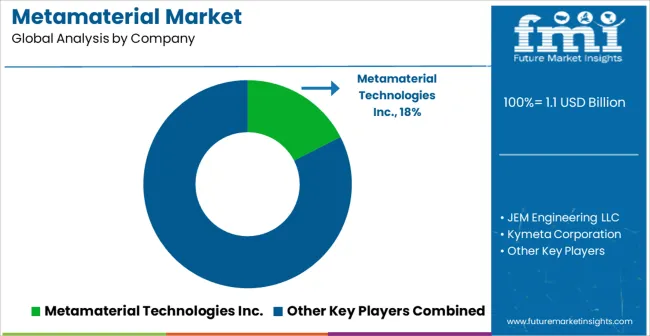
| Item | Value |
|---|---|
| Quantitative Units | USD 1.1 Billion |
| Material Type | Electromagnetic Metamaterial, Frequency Band Metamaterial, Terahertz Metamaterial, Photonic Metamaterial, Tunable Metamaterial, Plasmonic Met Material, and Other Types (Elastic, Acoustic, Structural, Etc.) |
| Application | Antenna, Solar Panel, Sensors, Absorber, Medical Imaging, Superlens, Seismic Protection, Sound Filtering, and Other |
| End-Use Industry | Aerospace & Defense, Electronics & Telecommunication, Automotive, Power Plants, and Medical |
| Regions Covered | North America, Europe, Asia-Pacific, Latin America, Middle East & Africa |
| Country Covered | United States, Canada, Germany, France, United Kingdom, China, Japan, India, Brazil, South Africa |
| Key Companies Profiled | Metamaterial Technologies Inc., JEM Engineering LLC, Kymeta Corporation, Microwave Measurement Systems LLC, Applied EM, Inc., Teraview, Alps Electric Co., Ltd, PARC, Echodyne, and Phoebus optoelectronics |
The global metamaterial market is estimated to be valued at USD 1.1 billion in 2025.
The market size for the metamaterial market is projected to reach USD 6.2 billion by 2035.
The metamaterial market is expected to grow at a 18.8% CAGR between 2025 and 2035.
The key product types in metamaterial market are electromagnetic metamaterial, frequency band metamaterial, terahertz metamaterial, photonic metamaterial, tunable metamaterial, plasmonic met material and other types (elastic, acoustic, structural, etc.).
In terms of application, antenna segment to command 22.9% share in the metamaterial market in 2025.






Our Research Products

The "Full Research Suite" delivers actionable market intel, deep dives on markets or technologies, so clients act faster, cut risk, and unlock growth.

The Leaderboard benchmarks and ranks top vendors, classifying them as Established Leaders, Leading Challengers, or Disruptors & Challengers.

Locates where complements amplify value and substitutes erode it, forecasting net impact by horizon

We deliver granular, decision-grade intel: market sizing, 5-year forecasts, pricing, adoption, usage, revenue, and operational KPIs—plus competitor tracking, regulation, and value chains—across 60 countries broadly.

Spot the shifts before they hit your P&L. We track inflection points, adoption curves, pricing moves, and ecosystem plays to show where demand is heading, why it is changing, and what to do next across high-growth markets and disruptive tech

Real-time reads of user behavior. We track shifting priorities, perceptions of today’s and next-gen services, and provider experience, then pace how fast tech moves from trial to adoption, blending buyer, consumer, and channel inputs with social signals (#WhySwitch, #UX).

Partner with our analyst team to build a custom report designed around your business priorities. From analysing market trends to assessing competitors or crafting bespoke datasets, we tailor insights to your needs.
Supplier Intelligence
Discovery & Profiling
Capacity & Footprint
Performance & Risk
Compliance & Governance
Commercial Readiness
Who Supplies Whom
Scorecards & Shortlists
Playbooks & Docs
Category Intelligence
Definition & Scope
Demand & Use Cases
Cost Drivers
Market Structure
Supply Chain Map
Trade & Policy
Operating Norms
Deliverables
Buyer Intelligence
Account Basics
Spend & Scope
Procurement Model
Vendor Requirements
Terms & Policies
Entry Strategy
Pain Points & Triggers
Outputs
Pricing Analysis
Benchmarks
Trends
Should-Cost
Indexation
Landed Cost
Commercial Terms
Deliverables
Brand Analysis
Positioning & Value Prop
Share & Presence
Customer Evidence
Go-to-Market
Digital & Reputation
Compliance & Trust
KPIs & Gaps
Outputs
Full Research Suite comprises of:
Market outlook & trends analysis
Interviews & case studies
Strategic recommendations
Vendor profiles & capabilities analysis
5-year forecasts
8 regions and 60+ country-level data splits
Market segment data splits
12 months of continuous data updates
DELIVERED AS:
PDF EXCEL ONLINE
Metamaterial Absorbers Materials Market Size and Share Forecast Outlook 2025 to 2035

Thank you!
You will receive an email from our Business Development Manager. Please be sure to check your SPAM/JUNK folder too.
Chat With
MaRIA